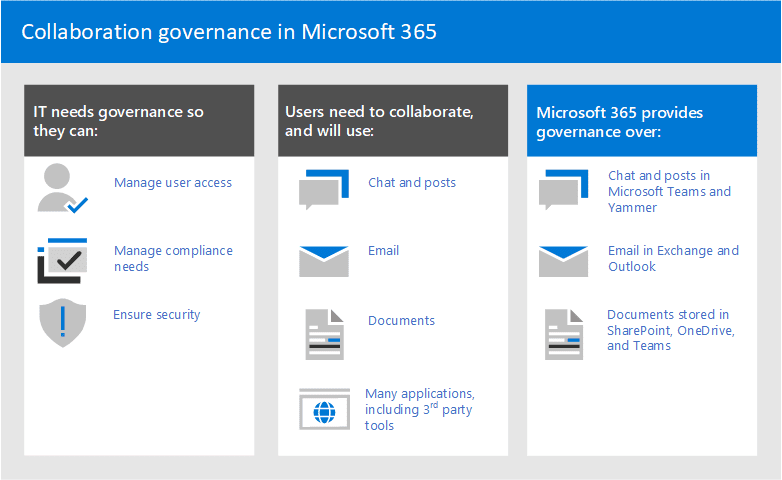Is Governance OOTB in Microsoft 365?
Good collaboration is definitely a cultural skill. The organizations who are best at collaboration are often those with a mature company culture, often with clearly defined governance and change management models that facilitate understanding and execution. Governance can be viewed as an umbrella term to describe multiple areas such as data governance, IT governance, corporate governance, etc. Furthermore, governance has a range of definitions based on which sector it is describing such as the public, financial, and healthcare sectors.
The first step to building a healthy governance strategy is always to sit down and discuss various organizational requirements and differences between teams and come to a shared understanding of your desired business outcomes — before any solution is proposed.
What Microsoft provides
Microsoft’s approach to governance in Office 365 has been to invest in two primary areas: the Administration Console, and in expanded documentation. For many years the partner community – independent software vendors (ISVs), strategic integrators (SIs) or consulting companies), and the MVP community – have provided content, tools, and expertise to help manage any and all gaps within the platform, but Microsoft has really stepped up their game in this area, investing heavily in the overall management experience of the platform, as well as the documentation in support of the features and tools that they bring to market.

This content is mostly workload-specific (SharePoint, Teams, Outlook, etc.) but provides a nice overview on the broader topic, with links into related topics. If you are just starting out on your planning activities, this is a great place to get started.
Potential gaps that organizations should plan for
When asked whether their organizations are generally good at managing governance activities across the various Office 365 workloads, most administrators identify themselves as “Average,” “Good” or “Excellent.” However, when you ask most admins specific questions about their specific governance activities within each workload, their confidence levels begin to wane.
One of the difficult lessons for many organizations, as with most user-driven technologies, is that technology is often unleashed without proper planning or governance processes in place. As a result, many administrators find themselves in reactionary modes and having to quickly research and retroactively apply standards across their environment. Even the most proactive, process-oriented organizations struggle from time to time with managing governance across rapidly deployed collaboration platforms and services, many of which are being acquired and deployed without the prior knowledge or oversight of the IT team.
A good governance strategy will outline the ways in which you intend to uphold policy and ensure your platform is performing optimally. Healthy governance is essential to any successful platform. A strong governance strategy, on the other hand, can have a direct impact on end user adoption and productivity, the level of management support received for current and future IT initiatives, and your ability to see measurable business value.
Governance should be a priority no matter what tools or platform you deploy, but certainly should be at the forefront of any decisions to roll out company-wide social tools. The recommendation is to begin by clarifying and documenting your permissions, information architecture, templates, content types, taxonomy within each workload— and ownership of each—and then map those requirements to your platform roadmap. Define what policies, procedures, and metrics are necessary to manage your entire environment, and then look at what is possible across your many different tools and platforms.




